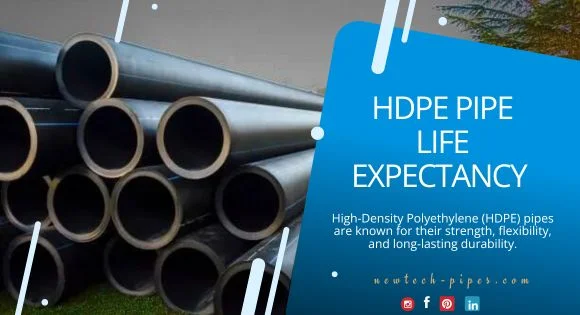High-Density Polyethylene (HDPE) pipes are widely known for their durability, flexibility, and cost-effectiveness in various industries. However, there are numerous misconceptions about the actual lifespan of these pipes. This blog separates myths from facts, offering clear insights into how HDPE pipes perform under different conditions.
HDPE Pipe Life Expectancy Explained: Myths vs Facts
High-Density Polyethylene (HDPE) pipes have gained immense popularity over the years due to their strength, flexibility, and cost-effectiveness. However, there are a lot of misconceptions about the lifespan and durability of HDPE pipes. This article aims to dispel the myths and highlight the facts, providing a comprehensive understanding of the longevity and performance of HDPE piping systems.
What Are HDPE Pipes?
Definition of HDPE
HDPE (High-Density Polyethylene) is a thermoplastic polymer made from petroleum. It’s known for its high strength-to-density ratio, making it ideal for various piping applications. HDPE pipes are primarily used for water, gas, and sewerage transmission, but their uses extend to many other sectors due to their resistance to chemicals, corrosion, and weathering.
Common Uses of HDPE Pipes
HDPE pipes are widely used in:
- Water supply systems
- Gas distribution networks
- Sewage and drainage systems
- Irrigation systems
- Industrial applications
- Mining operations
Their flexibility, durability, and ease of installation have made them a top choice for infrastructure projects around the world.
Myths About HDPE Pipe Life Expectancy
Despite the proven benefits of HDPE pipes, various myths about their longevity persist. Let’s explore some of the most common misconceptions:
Myth 1: HDPE Pipes Have a Short Lifespan
Many people assume that because HDPE is a type of plastic, it has a short lifespan. This couldn’t be further from the truth. HDPE pipes, when installed and maintained correctly, can last for 50 to 100 years or more. The misconception stems from a lack of understanding of the material’s properties.
Myth 2: Environmental Conditions Significantly Shorten HDPE Pipe Lifespan
While it’s true that environmental factors like UV exposure and extreme temperatures can affect some materials, HDPE pipes are designed to withstand harsh conditions. Special additives like UV stabilizers are often incorporated into HDPE pipes, allowing them to endure prolonged sun exposure without degradation.
Myth 3: HDPE Pipes Are Prone to Chemical Damage
Another common myth is that HDPE pipes are easily damaged by chemicals. However, HDPE is resistant to a wide range of chemicals, making it ideal for industrial applications where chemical exposure is common. The material’s resilience adds to its longevity in environments where other materials might fail.
Facts About HDPE Pipe Longevity
Fact 1: HDPE Pipes Have an Exceptionally Long Life Expectancy
HDPE pipes can last anywhere between 50 to 100 years when used in appropriate conditions. This long life expectancy is attributed to the pipe’s resistance to corrosion, flexibility, and the ability to withstand both high and low temperatures. Unlike metal pipes, HDPE doesn’t corrode, which dramatically extends its service life.
Fact 2: HDPE Is Highly Resistant to External Factors
HDPE pipes are resistant to a range of environmental and mechanical stressors. Factors like soil movement, earthquakes, and heavy loads don’t typically compromise the integrity of HDPE pipes. Their flexibility allows them to bend and adapt to shifting soil conditions, which reduces the likelihood of breaks or leaks.
Fact 3: HDPE Pipes Are Low Maintenance
The maintenance requirements for HDPE pipes are minimal compared to other materials like steel or concrete. Their corrosion resistance means fewer repairs and less frequent replacements. When properly installed, HDPE pipes can function efficiently for decades with minimal intervention.
Factors That Affect HDPE Pipe Life Expectancy
While HDPE pipes are known for their longevity, several factors can influence their life expectancy:
1. Installation Quality
Proper installation is crucial for ensuring the longevity of HDPE pipes. Poor installation practices, such as improper fusion of joints or inadequate bedding, can lead to failures and reduce the lifespan of the pipe.
2. Operating Conditions
The operating pressure and temperature of the fluid being transported can impact the life expectancy of HDPE pipes. It’s essential to use pipes that are designed to handle the specific conditions of the system to avoid premature failure.
3. Exposure to UV Radiation
HDPE pipes used in outdoor applications are often exposed to sunlight, which can cause degradation over time. However, pipes with UV stabilizers are designed to withstand such exposure for extended periods.
4. Chemical Exposure
While HDPE pipes are resistant to a broad range of chemicals, prolonged exposure to certain aggressive chemicals can reduce their lifespan. It’s important to choose the right grade of HDPE for specific applications to ensure maximum longevity.
5. Soil Conditions
The type of soil in which the HDPE pipes are buried can also affect their lifespan. Acidic or highly alkaline soils can potentially degrade the pipe material over time. It’s crucial to assess the soil conditions before installation to ensure compatibility with HDPE.
Comparing HDPE Pipes to Other Materials
HDPE pipes stand out due to their unique characteristics, but how do they compare to other materials commonly used in piping systems?
HDPE vs. PVC Pipes
PVC (Polyvinyl Chloride) pipes are also a popular choice for water and sewage systems. However, HDPE pipes are generally more flexible and durable than PVC pipes. HDPE can handle high-pressure applications better and has a longer life expectancy, especially in environments with fluctuating temperatures.
HDPE vs. Steel Pipes
Steel pipes are known for their strength but are prone to corrosion, which shortens their lifespan significantly. HDPE, on the other hand, is corrosion-resistant, making it a better long-term investment in corrosive environments such as underground or marine applications.
HDPE vs. Concrete Pipes
Concrete pipes are often used in large-scale infrastructure projects, but they are heavy, expensive to transport, and susceptible to cracking over time. HDPE pipes, in contrast, are lightweight, flexible, and less likely to crack under pressure or soil movement.
How to Maximize the Life Expectancy of HDPE Pipes
Although HDPE pipes are designed for long-term use, certain practices can help maximize their life expectancy:
1. Proper Installation and Fusion
Ensuring that the pipes are properly installed and the joints are correctly fused is crucial for avoiding premature failure. Using trained professionals and adhering to best practices during installation can help guarantee the pipe’s longevity.
2. Regular Inspection and Maintenance
While HDPE pipes require minimal maintenance, regular inspections can help identify potential issues before they become serious problems. Periodic checks for leaks, cracks, or damage can extend the lifespan of the system.
3. Using the Right Grade of HDPE
Different applications may require different grades of HDPE. For example, pipes used in high-pressure environments should be made from HDPE material that can withstand the specific demands of the application. Choosing the appropriate grade can prevent premature wear and tear.
4. Avoiding Overpressure and Overheating
Operating HDPE pipes within their designated pressure and temperature limits is essential for ensuring their longevity. Overpressure or overheating can weaken the material and lead to failures over time.
Real-World Examples of HDPE Pipe Durability
Case Study 1: Water Infrastructure in Europe
In several European countries, HDPE pipes have been used in water infrastructure projects for over 50 years, with minimal signs of wear. These pipes have survived harsh winter conditions, soil movement, and heavy traffic loads, proving their durability in real-world applications.
Case Study 2: Mining Operations in Australia
HDPE pipes have been successfully used in Australian mining operations for over two decades. The pipes have withstood extreme temperatures, chemical exposure, and mechanical stress, demonstrating their resilience in demanding industrial environments.
Conclusion: Myths vs. Facts on HDPE Pipe Life Expectancy
When it comes to the life expectancy of HDPE pipes, the facts clearly outweigh the myths. These pipes are not only long-lasting but also resistant to various environmental and chemical challenges. With proper installation, maintenance, and operating conditions, HDPE pipes can easily exceed 50 years of service, making them a reliable and cost-effective choice for modern infrastructure projects. By debunking the myths and focusing on the facts, industries can make informed decisions and take full advantage of HDPE’s durability and longevity.
FAQs on HDPE Pipe Life Expectancy
Q1: How long do HDPE pipes last?
A: HDPE pipes typically last between 50 to 100 years, depending on factors like installation quality and environmental conditions.
Q2: Are HDPE pipes resistant to UV radiation?
A: Yes, HDPE pipes with UV stabilizers are designed to withstand prolonged exposure to sunlight without degrading.
Q3: What makes HDPE pipes different from PVC pipes?
A: HDPE pipes are more flexible and durable than PVC pipes, especially in high-pressure or temperature-sensitive environments.
Q4: Can chemicals reduce the lifespan of HDPE pipes?
A: HDPE pipes are resistant to a wide range of chemicals, but prolonged exposure to aggressive chemicals can reduce their lifespan.
Q5: Do HDPE pipes require regular maintenance?
A: HDPE pipes require minimal maintenance due to their corrosion resistance, but regular inspections can help identify potential issues early.
Q6: What factors affect the longevity of HDPE pipes?
A: Installation quality, operating pressure, temperature, chemical exposure, and soil conditions all play a role in the longevity of HDPE pipes.
Q7: Are HDPE pipes suitable for extreme temperatures?
A: Yes, HDPE pipes can perform well in both high and low-temperature environments, making them versatile for various applications.
Q8: How can I ensure HDPE pipes last longer?
A: Proper installation, regular inspections, and choosing the correct grade of HDPE for your application can significantly extend the lifespan of your pipes.


